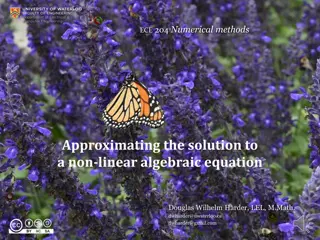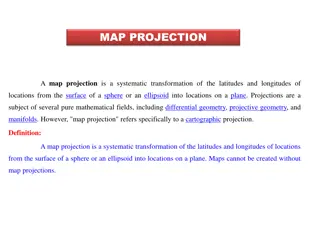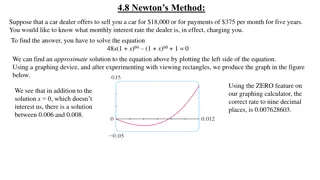Solving right triangles
Discover how to solve right triangles using trigonometric ratios and angle measures. Explore examples and real-world applications, such as calculating street grades in San Francisco. Learn how to identify angles using sine, cosine, and tangent ratios, and use inverse trigonometric functions to find
0 views • 26 slides
Line Segment Intersection
Geometric intersections play a crucial role in computational geometry for tasks such as solid modeling, collision detection in robotics, and overlaying subdivisions in geographic information systems. The problem of line segment intersection involves finding all intersection points between a set of c
0 views • 17 slides
Coordinates on the Unit Circle
Exploring how the coordinates on the unit circle correspond to trigonometric functions like sine, cosine, and tangent. Learn how to find these values for angles on the unit circle and how to apply trigonometry principles when points are not on the unit circle.
9 views • 6 slides
Approaches for Approximating Non-Linear Equations
Techniques for approximating solutions to non-linear algebraic equations involve converting the problem into a root-finding one. Seven methods such as Newton's method, bisection method, and linear interpolation are utilized with specific halting conditions. Tangent and secant lines, as well as Taylo
1 views • 13 slides
Understanding Line Sweep Algorithms in Geometry
Line sweep algorithms are a powerful tool for solving geometry problems by simulating the sweeping of a vertical line across a plane. This approach allows for efficient processing of important points and addressing various geometric challenges, such as finding the closest pair of points, determining
2 views • 10 slides
Understanding Map Projections: Types and Applications
Map projection is a systematic transformation of latitudes and longitudes from a curved surface to a flat plane. There are various classifications based on construction methods, tangent surface position, view point of light, and qualities like equal area and equi-distance. Zenithal Polar Equidistanc
0 views • 9 slides
Understanding Basic Trigonometry Concepts
Trigonometry is the study of triangles and the relationship between their sides and angles, particularly in right triangles. This introduction covers the basic trigonometric functions such as sine, cosine, and tangent, explaining their ratios in relation to angles and sides. By understanding these f
0 views • 16 slides
Exploring Circles and Tangents in Geometry
Journey through the world of circles, exploring special segments, lines, and properties like radius, chord, diameter, secant, and tangent. Dive into the intersections and relationships of circles, lines, and segments to deepen your understanding of geometric concepts.
1 views • 49 slides
Understanding Performance of Transmission Lines in Electrical Engineering
The performance of a transmission line in power systems is critical for efficient operation. Factors such as voltage drop, line losses, and transmission efficiency are key considerations in design and operation. The line parameters of resistance, inductance, capacitance, and shunt conductance play c
2 views • 26 slides
Visualizing Real Numbers on a Number Line by Successive Magnification
Visualization techniques for representing real numbers on a number line through successive magnification are demonstrated step by step. The procedure involves dividing the line into equal parts and zooming in on specific ranges to accurately locate decimal values. This method helps in understanding
0 views • 12 slides
Visualizing Real Numbers on a Number Line
The procedure of representing real numbers on a number line through successive magnification is explained in detail. It involves dividing the line, marking points, and magnifying specific intervals to accurately position numbers like 5.2316. Each real number corresponds to a unique point on the numb
0 views • 12 slides
Understanding Circles: Tangents, Inscribed Angles, and Theorems
Explore the concept of circles in geometry, focusing on tangent lines, inscribed angles, and related theorems. Understand the properties of tangents, relationships between angles and arcs, and how to apply theorems in circle problems. Visual examples and explanations included.
1 views • 19 slides
Understanding Newton's Method for Solving Equations
Newton's Method, also known as the Newton-Raphson method, is a powerful tool for approximating roots of equations. By iteratively improving initial guesses using tangent lines, this method converges towards accurate solutions. This method plays a crucial role in modern calculators and computers for
0 views • 12 slides
Exploring Geometry Vocabulary with Mr. Fiore & Mr. Ryan
Geometry, the study of shapes, has its roots in Ancient Mesopotamia and Ancient Egypt. Concepts such as point, line, ray, endpoint, line segment, vertex, congruent, vertical line, horizontal line, and plane are essential in understanding geometric relationships and structures. This visual guide prov
0 views • 22 slides
Understanding Line and Staff Authority in Organizational Structure
Line authority flows from top to bottom in an organization, while staff authority is provided by specialists to advise line managers. Staff members offer expert advice and support to enhance the efficiency of line officials. Different types of staff positions exist, such as personal staff, specializ
0 views • 5 slides
Calculus Examples and Practice
Explore various calculus problems involving finding gradients, equations of tangents and normals, and analyzing curves. Practice determining gradients at specific points, solving for coordinates, and differentiating equations to find tangent and normal lines. Understand the relationship between grad
1 views • 11 slides
Trigonometry: Identities, Equations, and Problem Solving Techniques
Explore various trigonometric identities, solve trigonometry equations, and learn problem-solving techniques in trigonometry. Discover how to use basic trigonometry to find missing sides, understand trigonometric identities, and tackle challenging trigonometry problems involving sine, cosine, and ta
1 views • 17 slides
Understanding Electric Field Lines and Charges
Electric field lines provide a visual representation of the electric field around charges. They show the direction of the electric field and help understand the intensity of the field at different points. Field lines never cross each other and the tangent at any point on a line gives the field direc
0 views • 40 slides
Understanding Trigonometric Ratios and Examples
Trigonometry involves studying the relationships between the angles and sides of triangles. This content covers trigonometric ratios in right-angled triangles, including sine, cosine, tangent, secant, cosecant, and cotangent. It provides examples and illustrations to help understand how to apply the
1 views • 20 slides
Understanding Least-Squares Regression Line in Statistics
The concept of the least-squares regression line is crucial in statistics for predicting values based on two-variable data. This regression line minimizes the sum of squared residuals, aiming to make predicted values as close as possible to actual values. By calculating the regression line using tec
0 views • 15 slides
Maternity Leave Guidance for Line Managers at the University
The Maternity Leave Guidance for Line Managers at the University emphasizes compassion and support for expectant mothers. It outlines essential steps for line managers before, during, and after maternity leave, including notifying HR of pregnancy, conducting risk assessments, discussing leave plans,
0 views • 8 slides
Understanding Energy Distribution System Line Models
This presentation delves into the various line models used in energy distribution systems, including exact line segment models and their derivation from Kirchhoff's voltage and current laws. The discussion covers three line segment models, the computation of phase impedance and admittance matrices,
0 views • 44 slides
Understanding Line Graphs: Year 6 Lesson Overview
This document provides an introduction to interpreting line graphs for Year 6 students. It covers key concepts, reviews essential skills, explores precise mathematical vocabulary, and includes lesson clips on right angles and perpendicular lines. The journey through the lesson involves a focus on pe
0 views • 26 slides
Understanding Trigonometric Ratios and Functions in Algebra 2
This chapter in Algebra 2 focuses on trigonometric ratios and functions related to right triangles. It covers concepts such as sine, cosine, tangent, cotangent, secant, and cosecant functions. The content explains how to evaluate these functions for angles in right triangles, special right triangles
0 views • 37 slides
Understanding Trigonometric Ratios in Right Triangles
Learn about trigonometric ratios like sine, cosine, and tangent in right triangles, and how to find side lengths and solve real-world problems using these ratios. Understand the AA Similarity Postulate and how to write trigonometric ratios as fractions and decimals. Dive into examples and exercises
0 views • 49 slides
Efficient Line Segment Intersection Algorithm
This content discusses the Line Segment Intersection problem and presents an efficient algorithm using the line sweep technique. The algorithm utilizes ordered sets implemented as balanced search trees to efficiently determine if any two line segments intersect in the plane. By sorting endpoints and
0 views • 10 slides
Understanding Line of Fit in Data Analysis
Line of fit is used in data analysis to model data with an approximate linear relationship. Through examples, you can learn how to find a line of fit, create scatter plots, sketch fitting lines, and estimate values based on the line of fit equation.
1 views • 13 slides
Exploring Circle Concepts and Theorems
Dive into the world of circles with this comprehensive guide covering important terms like center, radius, circumference, and theorems such as double angle, semicircle, and cyclic quadrilateral. Learn about isosceles triangles, tangent properties, chord relationships, and more through visual example
1 views • 21 slides
Understanding Pole and Line Fishing Methods and Gear
Pole and line fishing is a traditional method involving a hooked line attached to a pole. This technique is commonly used for both sport fishing and commercial fisheries. Learn about the gear types, target species, vessel types, and auxiliary equipment used in pole and line fishing. Discover the spe
0 views • 10 slides
Talk-Line: A Helpline for Students in Grades 3-5
Talk-Line is a resource available for students in Grades 3-5 who are experiencing thoughts of self-harm, being harmed by others, or needing help. This service provides a safe space for students to talk to a trained listener for support and assistance. It is essential for students to reach out to tru
0 views • 12 slides
Types of Ration Cards in India and Their Benefits
In India, there are 5 types of ration cards - Priority Household (PHH), Antyodaya (AAY), APL (Above Poverty Line), BPL (Below Poverty Line), and AAY (Antyodaya). Each card serves a specific category of households, providing different amounts of food grain allocation per month. The PHH card is for el
0 views • 8 slides
THVD8000 Line Driver for AC Line PLC Bench Setup
Explore the setup of THVD8000 line driver for AC line PLC, including transmitting and receiving paths, signal flow, power distribution, and components involved. Follow the signal path from THVD8000EVM to AFE031 boostpack, transformer, HV capacitor, and UCC28880EVM. Understand the power flow from AC
0 views • 11 slides
Automated Data Mining Toolkit for ALMA Science Products
The ADMIT (ALMA Data Mining Toolkit) developed by the University of Maryland, University of Illinois, and NRAO enables the generation of science products from data cubes. It supports first-view data products like spectra, line identification, and moment maps, facilitating analysis for galaxies like
0 views • 5 slides
Bresenham Line Drawing Algorithm Explained with Examples
Bresenham Line Drawing Algorithm is a method used to generate points between starting and ending coordinates to draw lines efficiently. This algorithm involves calculating parameters, decision parameters, and iteratively finding points along the line. Two example problems are provided with step-by-s
0 views • 8 slides
Trigonometry Concepts: Graphs, Symmetry, and Laws Explained
Explore trigonometry concepts such as sine, cosine, and tangent graphs, symmetry in trigonometric functions, and laws of trigonometric functions. Understand how to determine values using symmetry and graph analysis. Practice identifying values in the range 0 to 360 for sine, cosine, and tangent func
0 views • 22 slides
Understanding the Tangent Ratio in Trigonometry
Explore the concept of the tangent ratio in trigonometry through explicit teaching and visible learning objectives. The content covers identifying hypotenuse, opposite, and adjacent sides in right-angled triangles, understanding the relationship between trigonometric values, and writing tangent rati
0 views • 8 slides
Optimizing Line Coding for PM-PHY: A Detailed Analysis
Enabling line coding and channel equalization methods for PM-PHY, the IEEE 802.15.13 standard introduces overhead while enhancing channel adaptation. This contribution proposes 64b67b and Uniform Line Coding as alternative transmission modes, aiming to reduce line coding overhead while maintaining a
0 views • 26 slides
Solving for the Radius of the Smallest Circle in Three Circles and a Tangent
Three circles with a common tangent are depicted, and the radii of the larger circles are provided in the diagram. By using geometric properties and calculations, the value of the radius of the smallest circle can be determined accurately.
0 views • 29 slides
Exploring Data Science at the Command Line with UNIX and Vim
Delve into the world of data science through the command line, UNIX, and Vim, which offer agile, filesystem-integrated, scalable, and extensible solutions. Discover the significance of the command line, its integration with other technologies, and the role it plays in supercomputing and remote compu
0 views • 29 slides
Accelerating Local Ensemble Tangent Linear Models
This research focuses on accelerating Local Ensemble Tangent Linear Models with order reduction, exploring methods, results, and implications for advancing numerical modeling in atmospheric and oceanic systems. The study addresses challenges in maintaining accurate TLMs and adjoints for coupled mode
0 views • 21 slides







































